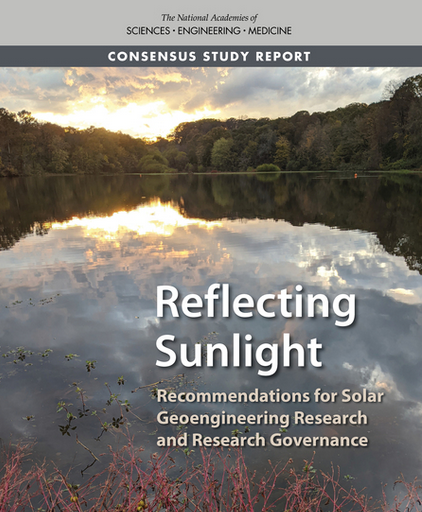The U.S. National Academy of Sciences has published a new report ("Reflecting Sunlight") on the topic of Geoengineering (that is, the deliberate manipulation of the global Earth environment in an effort to offset the effects of human carbon pollution-caused climate change). While I am, in full disclosure, a member of the Academy, I offer the following comments in an entirely independent capacity:
Let me start by congratulating the authors on their comprehensive assessment of the science. It is solid as we would expect, since the author team and reviewers cover that well in their expertise. The science underlying geoengineering is the true remit of the study. Chris Field , the lead author, is a duly qualified person to lead the effort, and did a good job making sure that intricacies of the science are covered, including the substantial uncertainties and caveats when it comes to the potential environmental impacts of some of the riskier geoengineering strategies (i.e. stratosphere sulphate aerosol injection to block out sunlight).
I like the fact that there is a discussion of the importance of labels and terminology and how this can impact public perception. For example, the oft-used term “solar radiation management” is not favored by the report authors, as it can be misleading (we don’t have our hand on a dial that controls solar output). On the other hand, I think that the term they do chose to use “solar geoengineering”, is still potentially problematic, because it still implies we’re directly modify solar output—but that’s not the case. We’re talking about messing with Earth’s atmospheric chemistry, we’re not dialing down the sun, even though many of the modeling experiments assume that’s what we’re doing. It’s a bit of a bait and switch. Even the title of the report, “Reflecting Sunlight” falls victim to this biased framing.
“They don’t actually put aerosols in the atmosphere. They turn down the Sun to mimic geoengineering. You might think that is relatively unimportant . . . [but] controlling the Sun is effectively a perfect knob. We know almost precisely how a reduction in solar flux will project onto the energy balance of a planet. Aerosol-climate interactions are much more complex.”
I have a deeper and more substantive concern though, and it really is about the entire framing of the report. A report like this is as much about the policy message it conveys as it is about the scientific assessment, for it will be used immediately by policy advocates. And here I’m honestly troubled at the fodder it provides for mis-framing of the risks.
I recognize that the authors are dealing with a contentious and still much-debated topic, and it’s a challenge to represent the full range of views within the community, but the opening of the report itself, in my view, really puts a thumb on the scales. It falls victim to the moral hazard that I warn about in “The New Climate War” when it states, as justification for potentially considering implementing these geoengineering schemes:
But despite overwhelming evidence that the climate crisis is real and pressing, emissions of greenhouse gases continue to increase, with global emissions of fossil carbon dioxide rising 10.8 percent from 2010 through 2019. The total for 2020 is on track to decrease in response to decreased economic activity related to the COVID-19 pandemic. The pandemic is thus providing frustrating confirmation of the fact that the world has made little progress in separating economic activity from carbon dioxide emissions.
First of all, the discussion of carbon emissions reductions there is misleading. Emissions flattened in the years
before the pandemic, and the International Energy Agency (IEA)
specifically attributed that flattening to a decrease in carbon emissions globally in the power generation sector. These reductions continue on and contributed at least party to the 7% decrease in global emissions last year. We will certainly need policy interventions favoring further decarbonization to maintain that level of decrease year after year, but if we can do that, we remain on a path to limiting warming below dangerous levels (decent chance less than 1.5C and very good chance less than 2C) without resorting on very risky geoengineering schemes. It is a matter of political willpower, not technology--
we have the technology now necessary to decarbonize our economy.
The authors are basically arguing that because carbon reductions haven’t been great enough (thanks to successful opposition by polluters and their advocates) we should consider geoengineering. That framing (unintentionally, I realize) provides precisely the crutch that polluters are looking for.
As I explain in the book:
A fundamental problem with geoengineering is that it presents what is known as a moral hazard, namely, a scenario in which one party (e.g., the fossil fuel industry) promotes actions that are risky for another party (e.g., the rest of us), but seemingly advantageous to itself. Geoengineering provides a potential crutch for beneficiaries of our continued dependence on fossil fuels. Why threaten our economy with draconian regulations on carbon when we have a cheap alternative? The two main problems with that argument are that (1) climate change poses a far greater threat to our economy than decarbonization, and (2) geoengineering is hardly cheap—it comes with great potential harm.
So, in short, this report is somewhat of a mixed bag. The scientific assessment and discussion is solid, and there is a discussion of uncertainties and caveats in the detailed report. But the spin in the opening falls victim to moral hazard and will provide fodder for geoengineering advocates to use in leveraging policy decision-making.
I am somewhat troubled by that.




